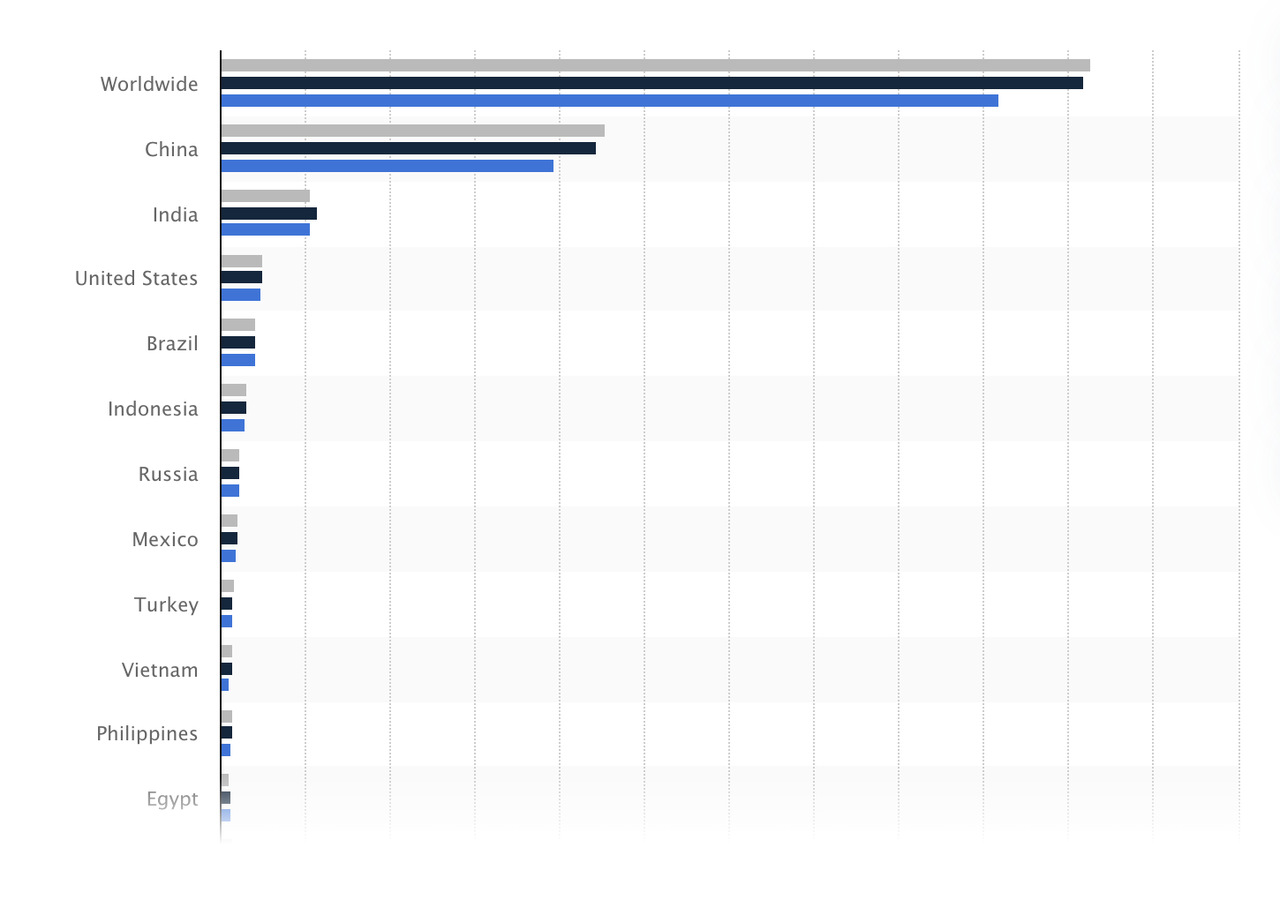There are millions upon millions of mobile apps in major app stores such as the App Store and Play Store. Competition is undoubtedly fierce.
Thus, it is a must that you, as a mobile developer or marketer, find creative and effective ways to attract more users.
Chief among these marketing strategies is called app localization.
Expanding into growing markets worldwide can dramatically improve your app’s success.
However, while emerging markets come with great opportunities, there are also challenges you need to deal with.
In this post, let us go through the importance of localizing your apps for emerging markets, the opportunities it presents, and the challenges you need to overcome to be successful.
Emerging Mobile App Markets
Did you know that in 2022, the mobile application market size was valued at USD 206.85 billion? What’s more, the compound annual growth rate (CAGR) of the mobile app market from 2023 to 2030 is around 13.8%. Other estimates put the number higher, at 22.97%.
This makes the mobile app industry one of the biggest markets spread throughout the world. Whatever report you read, there’s no doubt that the mobile app market is getting bigger and bigger.
What’s more interesting is that gone are the days when the United States led the world in mobile app downloads worldwide.
According to Statista, China was the leading country for app downloads in 2022, reaching up to 111 billion downloads. India follows in the ranking, with its people downloading 29 billion times in the same year.
Then comes the United States, which generated about 12.24 billion downloads.
Of course, you shouldn’t ignore other countries in the top 10 rankings.
To give you an idea of what other countries are included in the top 10 list and how many downloads are made in each country, you need to see this:
- China: 111 billion app downloads
- India: 29 billion app downloads
- United States: 12.24 billion app downloads
- Brazil: 10.61 billion app downloads
- Indonesia: 7.7 billion app downloads
- Russia: 5.48 billion app downloads
- Mexico: 5.08 billion app downloads
- Turkey: 3.73 billion app downloads
- Vietnam: 3.52 billion app downloads
- Philippines: 3.49 billion app downloads
As you can see, there’s a huge market outside of the United States waiting for you to tap into.
Just to give you an idea of what you’re missing, the combined app downloads of these countries are almost 180 billion, not including the United States.
With this in mind, you should start creating your app localization strategies to penetrate new global markets.
What are the New Opportunities for Localizing Apps?
When it comes to localizing apps, especially for emerging markets, there are numerous exciting opportunities to explore. Let’s take a closer look at some of these:
1. Market Expansion
Localizing apps allows businesses to expand into new and diverse markets, connecting with a global audience.
This approach opens doors to untapped user bases in different regions, potentially resulting in increased downloads, heightened user engagement, and enhanced revenue.
2. Enhanced User Engagement
Adapting app content to users’ language and cultural preferences offers a unique opportunity to improve overall user experience.
This, in turn, leads to increased engagement, heightened loyalty, and positive reviews. As users find the app more relatable and user-friendly, satisfaction and connection with the audience are significantly strengthened.
3. Increased Downloads and Visibility
Harnessing the power of app localization provides a significant opportunity for increased downloads and enhanced visibility.
Research indicates that apps with localized descriptions in the native language tend to experience higher download rates.
This strategy offers a twofold benefit: not only does it contribute to improved visibility within app stores, but it also translates into a potential boost in download numbers, consequently elevating the app’s ranking.
4. Revenue Growth
App localization offers a significant opportunity for revenue growth by expanding market share and increasing sales.
Businesses can capitalize on this benefit by tailoring their offerings to the specific needs and preferences of diverse markets, maximizing their revenue potential.
5. Competitive Edge
Having a localized app creates a significant opportunity to gain a competitive edge in crowded markets.
By demonstrating a dedicated commitment to user satisfaction, a localized app sets itself apart from competitors.
The benefit is clear: offering a more tailored and inclusive user experience compared to others in the market, ultimately securing a distinctive position and attracting a broader user base.
What are the Challenges for Localizing Apps?
With every opportunity comes challenges, and denying these challenges will only delay your app’s growth.
Thus, it’s crucial to be familiar with them so you can quickly create a game plan on how to address them.
Here are some of the most pressing challenges in localizing your app:
1. Linguistic and Cultural Nuances
Successfully adapting content for global audiences extends beyond literal translation, necessitating a profound comprehension of cultural nuances and idioms.
The repercussions of misinterpretations in this process can range from communication breakdowns to, in more severe instances, potential harm to the brand’s reputation.
2. Technical Adaptation
Technical adaptation poses a significant challenge in the process of localizing apps, requiring accommodation of diverse technical requirements.
This includes addressing issues such as text length variations and right-to-left languages.
The impact of this challenge is evident in the potential for creating inconsistent or poorly adapted user interfaces, which, in turn, can hinder the overall user experience and functionality of the app.
3. Legal and Regulatory Compliance
The challenge of legal and regulatory compliance during app localization involves adhering to the legal obligations of each target market, including compliance with data protection laws.
The potential impact of failing to meet these requirements is substantial and can lead to legal issues, financial penalties, or significant damage to the brand’s reputation.
4. Resource Intensiveness
App localization poses a challenge in terms of resource intensiveness, demanding significant investments of time, manpower, and financial resources.
The impact of inadequate resources can result in subpar localization efforts, compromising the overall quality of the app, particularly in specific markets where thorough adaptation is crucial for success.
5. Maintaining Consistency
One of the challenges in app localization is maintaining consistency across various language versions, encompassing branding and user interface elements.
The impact of this challenge is significant, as inconsistent messaging has the potential to confuse users and dilute the overall brand identity.
This emphasizes the importance of meticulous attention to uniformity throughout the localization process.
6. Testing and Quality Assurance
Rigorous testing and quality assurance are critical aspects of the app localization process.
Failing to address this challenge can have significant consequences, including the identification and rectification of linguistic and functional issues.
Overlooking thorough testing may result in the presence of bugs, errors, and a suboptimal user experience, ultimately leading to negative reviews and diminished user satisfaction.
7. App Store Optimization (ASO)
App Store Optimization (ASO) poses a challenge in the localization process as it involves meticulously adapting app store metadata and optimizing content for each target market.
The impact of ineffective ASO can be substantial, potentially leading to diminished visibility and lower download rates in specific regions.
Hence, a thoughtful and strategic approach to ASO is crucial to ensure the app’s success in diverse markets.
The Value Added by MobileAction
MobileAction’s Localization tool offers an overview of an app’s localized ASO elements (title, subtitle, and description) and its performance across active countries.
It allows you to uncover effective localization strategies, identify potential geographies for future localization, and gain insights into competitors’ global strategies.
You can analyze localized content, understand top-ranking countries, and refine your app’s localization strategy by comparing different apps’ approaches to strengthen your market position.
Penetrate Emerging Markets Effectively
Localizing your apps can be a challenging yet rewarding process.
While various obstacles may hinder your successful expansion into a new market, correct localization opens the floodgates to new opportunities.
This guest post from ShyftUp, a leading ASO Agency, sheds light on the transformative power of app localization.
With the relevant knowledge, skills, and tools, they can assist you in localizing your app, ensuring a smooth process, and positioning your app for the next level of success.






